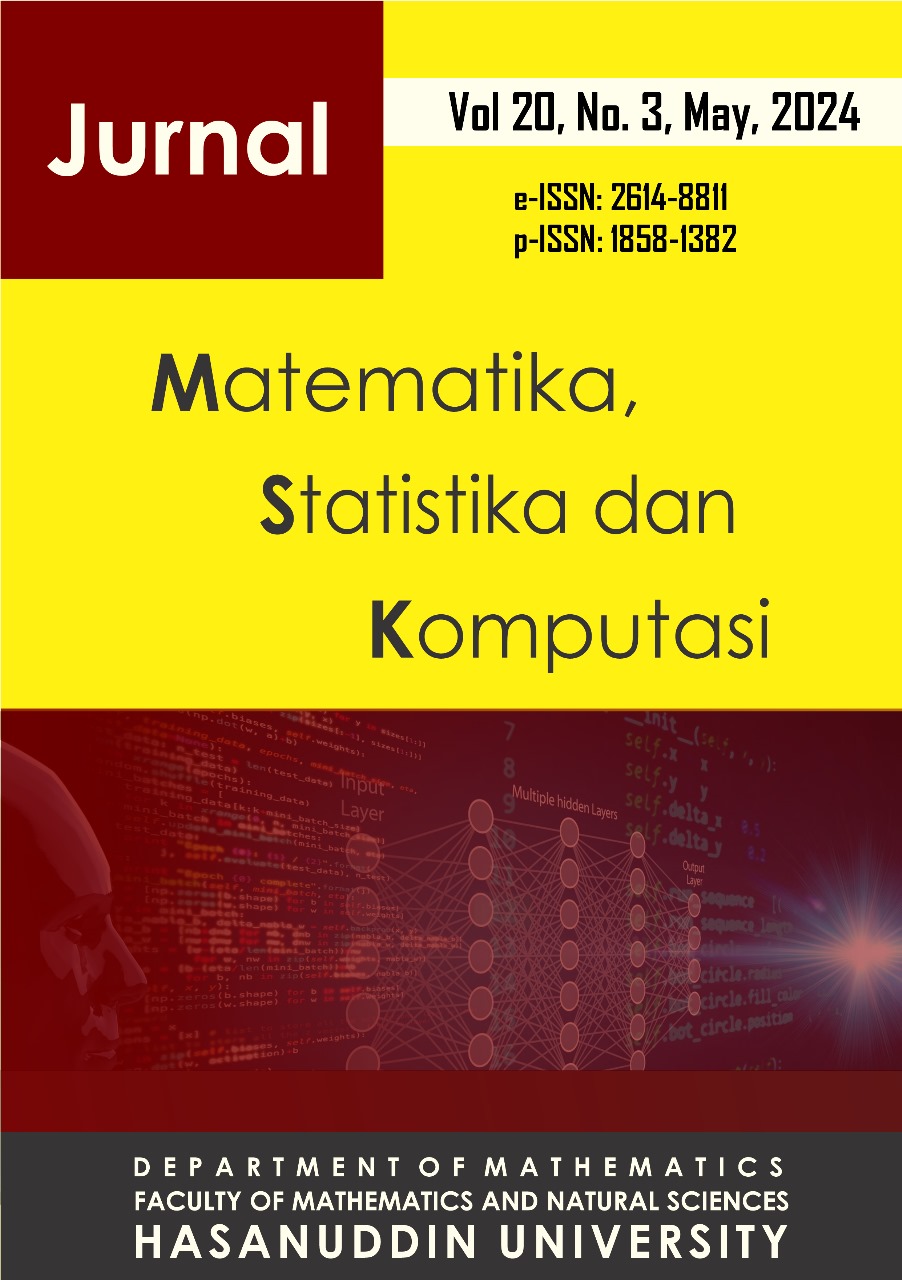Classification Of Country Status In 2022 Based On Social Indicators With Ordinal Logistic Regression
DOI:
https://doi.org/10.20956/j.v20i3.32356Keywords:
Country Classification, Ordinal Logistic Regression, Social IndicatorAbstract
This research examines the classification of country status in 2022 by applying ordinal logistic regression on various social indicators including education, health and economic. The urgency of the research is to know the country determine factors with specific factors in the form of research variables that can be useful for policy makers, unlike the existing classification which is only divided based on GDP per capita or HDI score only. By dividing 3 country status classes, namely not developed, developing and developed countries using the world bank classification baseline, the accuracy results were obtained at 72,5% but there were several variables that were not significant. After re-modelling, the accuracy was found increased to 76.4% with the odds ratio results for the minimum wage variable being 42,32 in the high class compared to the middle class and 11,66 for the middle class compared to the lower class, which means that the higher the minimum wage tends to be classify countries as developed countries. Another variable that has significance level is the birth rate with an odds ratio of 0,71 in the high and middle classes and 0.89 in the middle and lower classes comparison, which shows that this variable has a negative effect because the odds ratio is <1, which means that the higher the birth rate tends to make the country will be classified as a non-developed country.
References
. Alonso, J. A., Cortez, A. L., & Klasen, S., 2014. LDC and other country groupings: How useful are current approaches to classify countries in a more heterogeneous developing world? Global Governance and Rules for the Post-2015 Era, 347.
. Chen, Y. C., 2020. Lecture 7: Multinomial distribution. URL: http://faculty.washington.edu/yenchic/20A_stat512/Lec7_Multinomial.pdf. Diakses pada tanggal 12 Oktober 2023.
. Das, C., Sahoo, A. K., & Pradhan, C., 2022. Multicriteria recommender system using different approaches. In Cognitive Big Data Intelligence with a Metaheuristic Approach. Academic Press, 259-277.
. Delnord, M., Hindori‐Mohangoo, A. D., Smith, L. K., Szamotulska, K., Richards, J. L., Deb‐Rinker, P., ... & Macfarlane, A., 2017. Variations in very preterm birth rates in 30 high‐income countries: are valid international comparisons possible using routine data?. BJOG: An International Journal of Obstetrics & Gynaecology, 124(5), 785-794.
. Hosmer DW, Lemeshow S., 2000. Applied Logistic Regression. Ed ke-2. New York: John Wiley and Sons.
. Hua, C., Choi, Y. J., & Shi, Q., 2021. Companion to BER 642: Advanced regression methods. Bookdown. Retrieved August, 5, 2021.
. Khan, T., Abimbola, S., Kyobutungi, C., & Pai, M., 2022. How we classify countries and people—and why it matters. BMJ Global Health, 7(6), e009704.
. Li, H., & Zhang, J., 2007. Do High Birth Rates Hamper Economic Growth? The Review of Economics and Statistics 2007; 89 (1): 110–117. doi: https://doi.org/10.1162/rest.89.1.110.
. Mirjalili, S. H., & Saadat, H., 2020. How to escape the middle income trap in Iran? Lessons from Malaysia, Thailand South Korea and China. International Economic Studies, 50(1), 1-12.
. Pezzulo, C., Nilsen, K., Carioli, A., Tejedor-Garavito, N., Hanspal, S. E., Hilber, T., James, W. H. M., Ruktanonchai, C. W., Alegana, V., Sorichetta, A., Wigley, A. S. Hornby, G. M., Matthews, Z., & Tatem, A. J., 2021. Geographical distribution of fertility rates in 70 low-income, lower-middle-income, and upper-middle-income countries, 2010–16: a subnational analysis of cross-sectional surveys. The Lancet Global Health, 9(6), e802-e812.
. Suliyanto, 2023. Buku Ajar Regresi Terapan. Prodi S-1 Statistika FST Unair, Surabaya.
. Vázquez S. T. dan Sumner A., 2013. Revisiting the Meaning of Development: A Multidimensional Taxonomy of Developing Countries, The Journal of Development Studies, 49:12, 1728-1745, DOI: 10.1080/00220388.2013.822071.
. Widiatedja, I. G. N. P., 2021. Indonesia’s Export Ban on Nickel Ore: Does It Violate the World Trade Organization (WTO) Rules? Journal of World Trade, 55(4).
. Williams, C. C., & Horodnic, A. V., 2019. Why is informal employment more common in some countries? An exploratory analysis of 112 countries. Employee Relations: The International Journal, 41(6), 1434-1450.
Downloads
Published
How to Cite
Issue
Section
License
Copyright (c) 2024 Author and publisher

This work is licensed under a Creative Commons Attribution 4.0 International License.

This work is licensed under a Creative Commons Attribution 4.0 International License.
Jurnal Matematika, Statistika dan Komputasi is an Open Access journal, all articles are distributed under the terms of the Creative Commons Attribution License, allowing third parties to copy and redistribute the material in any medium or format, transform, and build upon the material, provided the original work is properly cited and states its license. This license allows authors and readers to use all articles, data sets, graphics and appendices in data mining applications, search engines, web sites, blogs and other platforms by providing appropriate reference.







